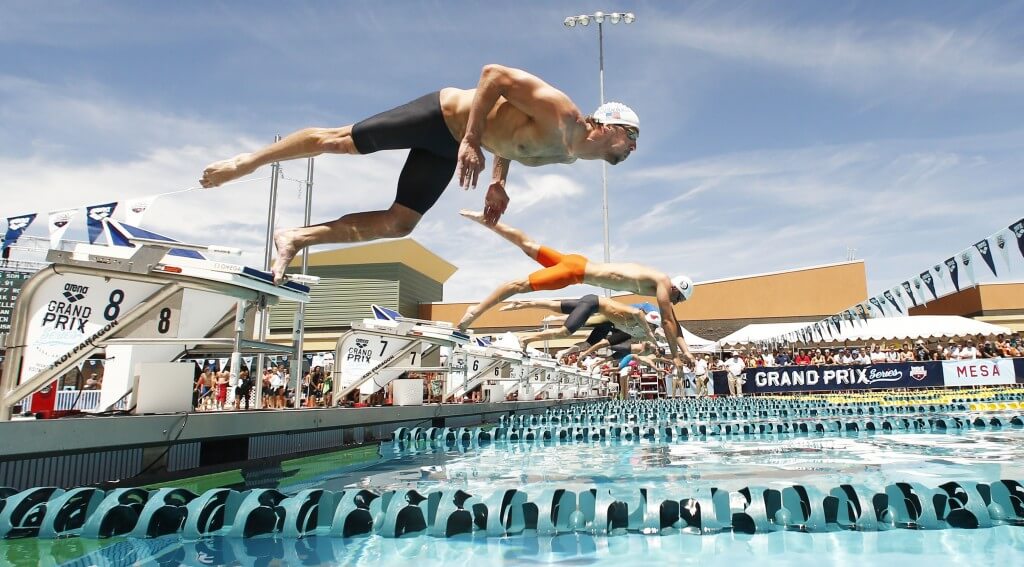Test Yourself with a Workout Fit for All Levels

PHOENIX, Arizona, June 12. SWIMMING World always welcomes volunteer contributions, especially when it comes to workout suggestions for our readers to think about and potentially use. Concord College head coach Ronald Hehn is the latest coach to submit one of his workouts to Swimming World.
Hehn is entering his second year as head coach at Concordia, and is the founder of the DakotaSota Swim Club in Fargo. Hehn had an impressive collegiate career as a All-American at Indiana University, and also swam at both the 2008 and 2012 U.S. Olympic Trials.
Today, Hehn presents a workout that could work for swimmers of all levels with Hehn describing it as traditional and mainstream. Hehn, however, may be providing some more USRPT-inspired workouts in the coming weeks. Hehn has become fairly prolific at releasing swimming workouts via his Facebook page. So, definitely take a look there for some thoughts.
Introduction
Warm-Up (Athletes must use this opportunity to rediscover their ‘feel’ for the water; Experiment with new drills and techniques)
Main Set (Inspired by Brad Hintermeyer, former coach; Build a PERFECT 25)
Warm-Down Set (Reduce effort per round; Hydrate and Stretch during rest; PERFECT Technique; EXPERIMENT – Invent a drill)
Summary
This workout challenges two fundamental components of proper exercise: the technical (i.e. technique) and physical (i.e. fitness) skill of the athlete. The workout contains 3 components: Warm-Up, Main Set, and Warm-Down Set.
Terms:
“Cori Cycle”: A metabolic pathway used when oxygen is not available to create energy. This is relevant because competitive swimming is a primarily anaerobic sport; the athlete primarily performs at a level that demands more oxygen than is available. Consequently, the Cori Cycle is essential to condition in order to maximize anaerobic metabolism and performance.
“Easy Speed”: Increased speed obtained by decreased effort. The athlete must focus on technical alterations that may result in increased efficiency. Increased efficiency results in increased speed (i.e. faster times) that occur at a decreased effort level.
“Hypoxic”: Without sufficient oxygen. The purpose of hypoxic training (i.e. restricted oxygen) is to a) increase comfort during underwater scenarios and b) engage the Cori Cycle for metabolism (i.e. hypoxic glycolysis; creation of energy without oxygen). It challenges the athlete to endure both Intermittent Breath Control (e.g. Breathe Every 3/5/7/9 Strokes) and Prolonged Breath Control (e.g. 4/6/8/10 Underwater Dolphin Kicks.)
Components
Warm-Up:
Preparation. The demand for effort increases with duration; the progressive element of warm-up (i.e. always building in difficulty) gradually increases heart rate while teaching the body to create energy under anaerobic conditions via the utilization of the Cori Cycle (i.e. anaerobic glycolysis). The body learns to identify and utilize this metabolic pathway under anaerobic conditions. The athlete learns to efficiently ration oxygen.
Main Set:
Speed. This component challenges the athlete’s ability to be explosive (i.e. sprinting) following the hypoxic segment, when the body is ready to utilize the Cori Cycle for anaerobic energy. In addition to the physiological benefit, the athlete must pay attention to the details of the technical component of their stroke under anaerobic conditions. The athlete learns to exert effort while maintaining perfect technique. The athlete should never sacrifice technique and efficiency for effort; the athlete can gain more speed from efficiency than from propulsion. Therefore, the athlete will learn to swim at a greater speed with less effort by increasing stroke mechanic efficiency.
Warm-Down Set:
Recovery. This component immediately follows speed work with an aerobic segment; the preponderance of evidence suggests that aerobic exercise accelerates recovery. I believe gradually decreasing effort from a “good effort” to “cruz” is the most effective method to clearing residual lactate generated during the sprint exercises. Often, swimmers’ warm-downs at practice and competitions neglect to contain a “good effort” component; instead opting to swim at a “cruz” effort throughout the entirety of warm-down. I believe beginning warm-down at a “good effort” improves recovery.
Workout Key:
Layout:
Reps x Distance @ Interval Movement Stroke Effort Level
Distance(Running Total Distance / Time (Running Total Time)
1 Length = 25 Yards
Repetition x Distance. Example: 4×25 (1 Length, 4 Times)
Interval:
@ = Signals the Interval. Example: 4×25 @ :30 (The athlete has :30 to complete each length, rest remainder, 4 Times)
@ R: A specific amount of time to take for rest, regardless of time taken to cover a distance (e.g. @ :10 R; 10 seconds rest)
Movement:
S = Swim (i.e. Full Strokes) K = Kick (i.e. Legs Only) D = Drill B = Break (i.e. Bathroom or Water opportunity)
Stroke:
NF = Non-Freestyle Stroke (i.e. Butterfly, Backstroke, or Breaststroke)
NC = Non-Competitive Stroke (i.e. any stroke other than Butterfly, Backstroke, Breaststroke, or Freestyle *Be Creative*)
Choice = Choose Butterfly, Backstroke, Breaststroke, or Freestyle (N.B. does not have to be the same stroke for entire distance)
Free (FR) = Freestyle (Crawl)Back (BA) = Backstroke (Back Crawl) Breast (BR) = Breaststroke Fly (FL) = Butterfly
Flutter (FK) = Flutter Kick
Effort Level:
*MAX HR Can be calculated by the formula: (220 – Age = MAX HR) (e.g. a 20 year old’s MAX HR is 200)
*HR Can be measured by counting the number of in 6 seconds, multiplied by 10 (e.g. 12 pulses in 6 seconds is a HR 120)
Float = 50-60% MAX HR, Focus on Body Alignment and Posture
cruz= 60-70% MAX HR: Focus on maintaining a consistent pace while swimming effortlessly
good effort = 70-80% MAX HR; Focus on swimming at a moderate pace while being aware of technical errors
Better Effort = 80-90% MAX HR; Focus on swimming at a moderate pace while repairing technical errors
BEST Effort = 90-100% MAX HR; Swim as fast as possible with PERFECT technique



